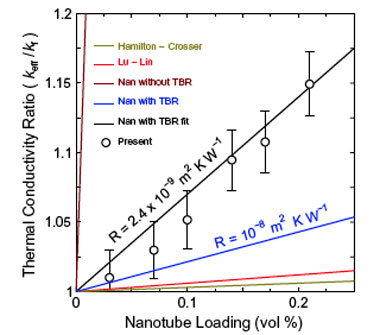| Posted: May 11, 2012 | |
Carbon nanotubes enhance performance of heat transfer nanofluids |
|
| (Nanowerk Spotlight) Nanofluids – engineered colloidal suspensions of nanoparticles in a base fluid – are attracting a great deal of interest with their enormous potential to provide enhanced performance properties. Particularly with respect to heat transfer, and compared with more conventional heat transfer fluids (i.e. coolants) currently available, nanofluidic coolants exhibit enhanced thermal conductivity. | |
| The European Union has even set up NanoHex, a cutting edge nanotechnology project that aims to develop a revolutionary cooling system for a range of industrial applications. Formulating carefully engineered nanofluids, the project hopes to unlock new development possibilities for more compact, lightweight, energy efficient and environmentally friendly processes and products. | |
| "Attempts to increase the thermal conductivity of heat transfer fluids using nanoparticles has been an active research area over the past decade," S. Harish, a PhD candidate in the Department of Mechanical Engineering at the University of Tokyo, tells Nanowerk. "However, these attempts have not resulted in a significant improvement in conductivity due to the low thermal conductivity of nanoparticles and high thermal boundary resistance around the 0-dimensional nanoparticles. We therefore decided to produce a nanofluid using single-walled carbon nanotubes because of their much higher thermal conductivity and their ability to form connected networks with the neighboring carbon nanotubes, thereby increasing the heat transfer path." | |
| The researchers, led by Shigeo Maruyama, found that their single-walled carbon nanotube (SWCNT) nanofluid exhibits an increase in conductivity of up to almost 15%; a value significantly higher than what has been achieved with nanoparticle-based nanofluids. | |
| The team has reported their findings in a recent paper, first-authored by Harish, in the International Journal of Heat and Mass Transfer: ("Enhanced thermal conductivity of ethylene glycol with single-walled carbon nanotube inclusions"). | |
| Dispersing high volumes of SWCNTs in non-aqueous solutions remains a challenging task. Often, acid treatment is employed for this purpose. However, as Harish points out, treating the nanotubes with strong acids induces defects in their structure and reduces the thermal properties of the material. Besides, thermal boundary resistance between nanotube and the surrounding fluid plays a detrimental role in obtaining higher thermal conductivity of the fluid. Steps need to be taken to minimize the thermal boundary resistance. | |
| In their paper, the authors have introduced an efficient way for the nanofluid research community to synthesize ultra-pure SWCNTs by using the alcohol catalytic chemical vapor deposition method. | |
| "Single walled nanotubes are highly hydrophobic and often bundled together due to high Van der Waals force of attraction," says Harish. "We made use of a bile salt to debundle the nanotubes to disperse them in the heat transfer fluid. Such dispersed single walled carbon nanotubes at very low volume concentration boost the thermal conductivity of conventional heat transfer fluid by almost 15%. This experimental observation holds the promise of the development of efficient coolants for the electronics and automobile industries." | |
 |
|
| Effective thermal conductivity of SWCNT/ethylene glycol dispersions and comparison with theoretical models. (Reprinted with permission from Elsevier) | |
| The scientists measured thermal conductivities of their SWCNT-dispersed ethylene glycol samples for different SWCNT loadings. They found that the thermal conductivity increased with increasing SWCNT loading in a slightly nonlinear fashion. A maximum enhancement of 14.8% at a loading of 0.21 vol% was found in this study. | |
| The team notes that classical models failed to predict their experimental results, i.e. that the effective thermal conductivity increased in nonlinear fashion with respect to the nanotube loading. For now, they consider the formation of a networking structure to be the potential reason behind the conductivity enhancement observed. | |
| "However, further work needs to be carried out to provide experimental evidence to explain the mechanism behind the heat conduction in nanofluids," says Harish. | |
 By
Michael
Berger
– Michael is author of three books by the Royal Society of Chemistry:
Nano-Society: Pushing the Boundaries of Technology,
Nanotechnology: The Future is Tiny, and
Nanoengineering: The Skills and Tools Making Technology Invisible
Copyright ©
Nanowerk LLC
By
Michael
Berger
– Michael is author of three books by the Royal Society of Chemistry:
Nano-Society: Pushing the Boundaries of Technology,
Nanotechnology: The Future is Tiny, and
Nanoengineering: The Skills and Tools Making Technology Invisible
Copyright ©
Nanowerk LLC
|
|
|
Become a Spotlight guest author! Join our large and growing group of guest contributors. Have you just published a scientific paper or have other exciting developments to share with the nanotechnology community? Here is how to publish on nanowerk.com. |
|
